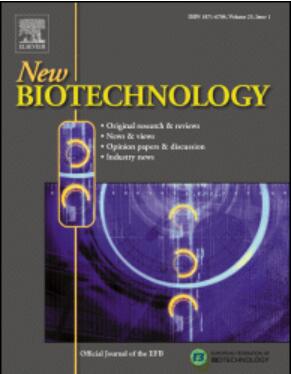Effect of salinity on the composition of a seawater-adapted strain of Scenedesmus almeriensis
IF 4.9
2区 生物学
Q1 BIOCHEMICAL RESEARCH METHODS
引用次数: 0
Abstract
The main objective of this study was to evaluate the potential adaptation to seawater of the freshwater strain Scenedesmus almeriensis and to evaluate the effect of salinity on its growth, morphology, and biochemical composition. Incorporating low seawater concentrations into the culture medium (up to 103 mM NaCl) resulted in an increase in biomass productivity from 0.15 to 0.22 g·L-¹ ·day-¹ and an increase in the maximum specific growth rate from 0.14 to 0.26 day-¹. This was attributed to the presence of micronutrients in the seawater and adaptive responses to stress. Despite a lower biomass productivity (0.11 g·L−1·day-¹), Scenedesmus almeriensis was able to grow well (0.15 day−1) in a medium formulated with only seawater and commercial fertilisers. Cell morphology was significantly affected, with a 150 % increase in cell perimeter and an increase in roundness from 61.5 % (freshwater) to 95.8 % (seawater). The use of seawater also affected the chemical composition of the biomass. Seawater favoured the synthesis of specific fatty acids that have nutritional and industrial value, including polyunsaturated fatty acids. The protein content was slightly reduced under saline conditions but remained at 40 % (which is high compared to other biomasses). The results highlight the potential of seawater as a sustainable and cost-effective substitute for freshwater to produce Scenedesmus almeriensis. Future studies will validate the production of these strains at the large scale and identify potential industrial uses for the biomass produced.
盐度对一株适应海水环境的绿僵菌组成的影响
本研究的主要目的是评估淡水菌株Scenedesmus almeriensis对海水的潜在适应能力,以及盐度对其生长、形态和生化组成的影响。在培养基中加入低浓度海水(最高为103 mM NaCl),生物量生产力从0.15增加到0.22 g·L-¹·day-¹,最大比生长率从0.14增加到0.26 day-¹。这归因于海水中微量营养素的存在和对压力的适应性反应。尽管生物量生产力较低(0.11 g·L−1·day- 1),但在仅由海水和商业肥料配制的培养基中,Scenedesmus almeriensis能够生长良好(0.15 day−1)。细胞形态受到显著影响,细胞周长增加了150 %,圆度从61.5 %(淡水)增加到95.8% %(海水)。海水的使用也影响了生物量的化学成分。海水有利于合成具有营养和工业价值的特定脂肪酸,包括多不饱和脂肪酸。在盐水条件下,蛋白质含量略有降低,但仍保持在40 %(与其他生物质相比,这是很高的)。研究结果强调了海水作为一种可持续的、具有成本效益的淡水替代品来生产almeriensis的潜力。未来的研究将验证这些菌株的大规模生产,并确定所生产的生物质的潜在工业用途。
本文章由计算机程序翻译,如有差异,请以英文原文为准。
求助全文
约1分钟内获得全文
求助全文
来源期刊

New biotechnology
生物-生化研究方法
CiteScore
11.40
自引率
1.90%
发文量
77
审稿时长
1 months
期刊介绍:
New Biotechnology is the official journal of the European Federation of Biotechnology (EFB) and is published bimonthly. It covers both the science of biotechnology and its surrounding political, business and financial milieu. The journal publishes peer-reviewed basic research papers, authoritative reviews, feature articles and opinions in all areas of biotechnology. It reflects the full diversity of current biotechnology science, particularly those advances in research and practice that open opportunities for exploitation of knowledge, commercially or otherwise, together with news, discussion and comment on broader issues of general interest and concern. The outlook is fully international.
The scope of the journal includes the research, industrial and commercial aspects of biotechnology, in areas such as: Healthcare and Pharmaceuticals; Food and Agriculture; Biofuels; Genetic Engineering and Molecular Biology; Genomics and Synthetic Biology; Nanotechnology; Environment and Biodiversity; Biocatalysis; Bioremediation; Process engineering.
 求助内容:
求助内容: 应助结果提醒方式:
应助结果提醒方式:


